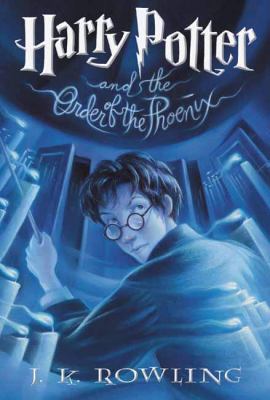
by J. K. Rowling
Library Journal Just in case you missed it in all the media, the fifth installment of the Harry Potter series is flying your way on June 21. It's one-third longer than Harry Potter and the Goblet of Fire, and Dumbledore promises to tell all. Copyright 2003 Reed Business Information. Copyright © Reed Business Information, a division of Reed Elsevier Inc. All rights reserved. Book list No, you can't put it down, but believe me, you'll wish you could. This is not an easy book to lug around. Its worldwide hype aside, the fifth installment in Harry Potter's saga should be judged on the usual factors: plot, characters, and the quality of the writing. So how does it fare? One thing emerges quickly: Rowling has not lost her flair as a storyteller or her ability to keep coming up with new gimcracks to astound her readers. But her true skills lie in the way she ages Harry, successfully evolving him from the once downtrodden yet hopeful young boy to this new, gangly teenager showing all the symptoms of adolescence--he is sullen, rude, and contemptuous of adult behavior, especially hypocrisy. This last symptom of the maturing Harry fits especially well into the plot, which finds almost all of the grown-ups in the young wizard's life saying one thing and doing another, especially those at the Ministry of Magic, who discredit Harry in the media to convince the citizenry that Voldemort is not alive. Rowling effectively uses this plot strand as a way of introducing a kind of subtext in which she takes on such issues as governmental lying and the politics of personal destruction, but she makes her points in ways that will be clearly understood by young readers. To fight for truth and justice--and to protect Harry--the Order of the Phoenix has been reconstituted, but young Potter finds squabbling and hypocrisy among even this august group. And in a stunning and bold move, Rowling also allows Harry (and readers) to view an incident from the life of a teenage James Potter that shows him to be an insensitive bully, smashing the iconic view Harry has always had of his father. Are there problems with the book? Sure. Even though children, especially, won't protest, it could be shorter, particularly since Rowling is repetitious with descriptions (Harry is always angry ; ultimate bureaucrat Doris Umbridge always looks like a toad). But these are quibbles about a rich, worthy effort that meets the very high expectations of a world of readers. --Ilene Cooper Copyright 2003 Booklist From Booklist, Copyright © American Library Association. Used with permission. Publishers Weekly Year five at Hogwarts is no fun for Harry. Rowling may be relying upon readers to have solidified their liking for her hero in the first four books, because the 15-year-old Harry Potter they meet here is quite dour after a summer at the Dursleys' house on Privet Drive, with no word from pals Hermione or Ron. When he reunites with them at last, he learns that The Daily Prophet has launched a smear campaign to discredit Harry's and Dumbledore's report of Voldemort's reappearance at the end of book four, Harry Potter and the Goblet of Fire. Aside from an early skirmish with a pair of dementors, in which Harry finds himself in the position of defending not only himself but his dreaded cousin, Dudley, there is little action until the end of these nearly 900 pages. A hateful woman from the Ministry of Magic, Dolores Umbridge (who, along with minister Cornelius Fudge nearly succeeds in expelling Harry from Hogwarts before the start of the school year) overtakes Hogwarts-GrandPrE's toadlike portrait of her is priceless-and makes life even more miserable for him. She bans him from the Quidditch team (resulting in minimal action on the pitch) and keeps a tight watch on him. And Harry's romance when his crush from the last book, Cho Chang, turns out to be a major waterworks (she cries when she's happy, she cries shen she's sad). Readers get to discover the purpose behind the Order of the Phoenix and more is revealed of the connection between Harry and You-Know-Who. But the showdown between Harry and Voldemort feels curiously anticlimactic after the stunning clash at the close of book four. Rowling favors psychological development over plot development here, skillfully exploring the effects of Harry's fall from popularity and the often isolating feelings of adolescence. Harry suffers a loss and learns some unpleasant truths about his father, which result in his compassion for some unlikely characters. (The author also draws some insightful parallels between the Ministry's exercise of power and the current political climate.) As hope blooms at story's end, those who have followed Harry thus far will be every bit as eager to discover what happens to him in his sixth and seventh years. Ages 9-12. (June) Copyright 2003 Reed Business Information. Copyright © Reed Business Information, a division of Reed Elsevier Inc. All rights reserved. |